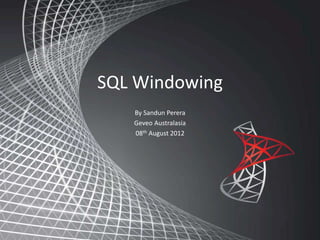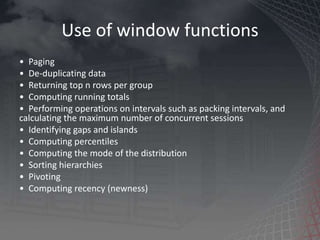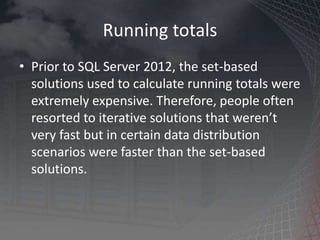This document discusses SQL windowing functions. It covers topics such as window aggregate functions like COUNT, SUM, AVG; set-based vs iterative programming; uses of window functions like paging, deduplicating data, and running totals; ranking functions; common table expressions; optimizing ranking functions; creating sequences; removing duplicate entries; pivoting; and what's new in SQL Server 2012 like distribution and offset functions.






![String concatenation
• Among many alternative solutions in SQL
Server to achieve ordered string
concatenation, one of the more efficient
techniques is based on XML manipulation
using the FOR XML option with the PATH
mode. SELECT SUBSTRING((SELECT ',' + Name as [text()]
FROM Production.ProductCategory
FOR XML PATH('')),
2, 100) AS Names](https://image.slidesharecdn.com/sqlwindowing-150610062740-lva1-app6891/85/SQL-Windowing-7-320.jpg)











![WITH C AS
(
SELECT YEAR(ModifiedDate) AS OrderYear,
MONTH(ModifiedDate) AS OrderMonth,
LineTotal as Amount
FROM Sales.SalesOrderDetail
)
SELECT *
FROM C
PIVOT(SUM(Amount)
FOR OrderMonth IN ([1],[2],[3],[4],[5],[6],[7],[8],[9],[10],[11],[12])) AS P;
• Suppose you need to query the Sales.OrderValues view and
return a row for each order year, a column for each order
month, and the sum of order values for each year and
month intersection. In this request, the on rows, or
grouping element is YEAR(orderdate); the on cols, or
spreading element is MONTH(orderdate); the distinct
spreading values are 1, 2, 3, 4, 5, 6, 7, 8, 9, 10, 11, and 12;
and the data, or aggregation element is SUM(val).](https://image.slidesharecdn.com/sqlwindowing-150610062740-lva1-app6891/85/SQL-Windowing-19-320.jpg)

![WITH C AS
(
SELECT YEAR(orderdate) AS orderyear, MONTH(orderdate) AS ordermonth, val
FROM Sales.OrderValues
)
SELECT orderyear, (CAST([1] AS VARCHAR) + ‘, ‘ + CAST([2] AS VARCHAR)) AS Totals
FROM C
PIVOT(SUM(val)
FOR ordermonth IN ([1],[2],[3],[4],[5],[6],[7],[8],[9],[10],[11],[12])) AS P;
orderyear Totals
----------------------------------------
2000 11011.75, 10952.62
2001 10926.32, 10759.00
2002 10856.55, 10682.69
2003 11016.10, 10953.25
2004 10924.99, 10875.14
2005 11058.40, 10956.20
2006 10826.33, 10679.79
...](https://image.slidesharecdn.com/sqlwindowing-150610062740-lva1-app6891/85/SQL-Windowing-21-320.jpg)






